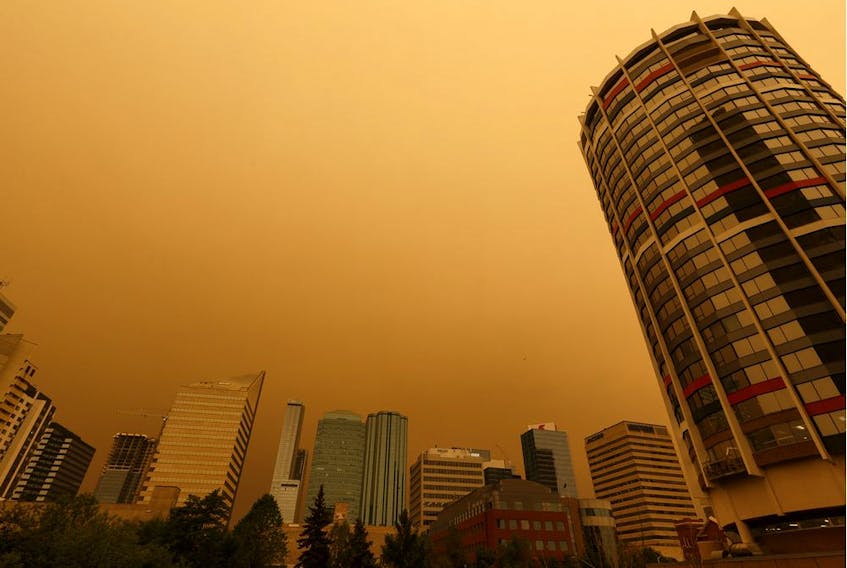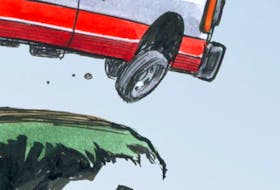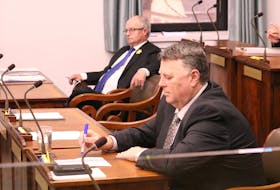Clean air shelters and urban fire bans, mandatory cancellation for youth sports — health and municipal officials in the Edmonton region will consider myriad ways to cope as bad smoke days grow more common.
That’s the prediction. A hotter, drier climate combined with Alberta’s forest management practices are already increasing the likelihood of intense fires. They start early, burn too hot to control and keep burning right through the summer.
Smoke could be the new mosquito, the summer buzzkill that keeps us indoors.
The Alberta Capital Airshed is hosting a conference June 20 on the issue, reviewing how other jurisdictions protect populations. It will include the latest health research on smoke-triggered heart attacks and the risk to a fetus or newborn, as well as a workshop on next steps for Edmonton and its neighbours.
Canada’s fire problem is complex. Traditionally, fires rolled across most parts of Alberta every 30 to 70 years, depending on the area. After the fire, the boreal forest would naturally progress from deciduous trees like aspen and poplar to coniferous trees such as pine or fir over the course of decades.
Then 100 years ago, forest officials started fighting fires. It protected the new towns and industrial facilities growing up in the forest, but also gradually caused a shift in forest composition. More stands of spruce, fir and pine now provide higher-value lumber for forest companies but also flame up like torches and burn more intensely when a fire gets established.

Today, forestry officials seek to preserve the diversity in tree stands that remain. But they allow forest companies to spray glyphosate, the active ingredient in Roundup, from helicopters to kill off aspen and regrow stands of drier conifers.
Combine that with climate change — hotter, drier weather, and more lightning storms to give ignition. It’s not a pretty picture.
Last Thursday’s smoke illustrated how bad it can get. Air quality readings at one Edmonton station hit 1,800 micrograms per cubic metre, way off the normal scale. Ashes littered tennis courts and front steps. The Airshed’s Kevin McCullum checked the numbers in disbelief. “I said, ‘Nah, that’s got to be a mistake.’ Normally there would be a problem with the analyzer.”
Nothing over 500 had been measured in Edmonton in the last 20 years.
“It has an effect on your body, even if you don’t feel those effects,” says Sarah Henderson, senior environmental health scientist with the B.C. Centre for Disease Control, who is presenting at the upcoming conference. She worries most about pregnant women and newborns with new, highly-sensitive lungs.
The particles in smoke are so small they get carried deep into the lungs, where the body thinks they’re foreign bacteria and tries to kill them. That causes the lungs to get inflamed. The particles also cross into the bloodstream, causing inflammation throughout the body, says Henderson.
That’s why researchers have found the rate of heart attacks increases one percent for each 10 microgram increase in these small smoke particles. The rate of respiratory illness increases seven per cent, she says, and the inflammation can reduce the flow of nutrients across the placenta in pregnant women, leading to lower birth weights.
Ten micrograms is roughly the difference between each number on the air quality scale, for example from a 4 to a 5. A good day in Edmonton is around 3, and at 7 health officials recommend children’s outdoor activity should be rescheduled.
People can give their bodies a break and a chance to recover by visiting a public building with a good H-VAC system, or by running even a $200 air purifier to clean a couple of rooms at home.
Alberta is still missing ground-level air quality monitors in much of the central and northwest regions. The province partnered with Environment Canada last year so it can still get air quality warnings out, but missing that data makes it harder to predict how the smoke at ground level is moving.
The provincial response last Thursday was tone deaf. More than 10,000 people had already been forced out of northern communities and smoke was rolling into Edmonton as the United Conservatives celebrated killing the carbon tax.
The premier’s spokeswoman even Tweeted the premier’s speech was “pure fire” as Jason Kenney killed off NDP’s signature move to try to counter climate change. Then smoke forced them cancel an outdoor media availability and get a wildfire update instead.
Later, Kenney said B.C. has had a carbon tax for 10 years and it hasn’t changed their wildfire season.
That’s incredibly simplistic. We need a wake-up call, not just to take action to limit the global increase in temperature, but also to be prepared. We need to look hard at our forest management practices to make sure they’re not making things worse, and be ready to cope with more smoke.
Climate records already show an increase of 2.4 C in annual temperature over the last 100 years for Edmonton. All the best evidence says it’s about to get much worse.
Copyright Postmedia Network Inc., 2019
RELATED
- 'You can come home': High Level mandatory evacuation order to be lifted Monday morning
- Slave Lake hits full capacity for evacuees as two out-of-control wildfires prompt evacuation order in Trout Lake
- 'The roads are melted': Métis settlements poised for evacuation after homes destroyed in Paddle Prairie
- Alberta wildfires: Estimated 10,000 people evacuated as multiple fires threaten northern Alberta communities
- Alberta wildfires: High Level prepares for residents to come home while fires prompt evacuations for other parts of northern Alberta
- Alberta wildfires: Tuesday winds aid firefighters, force air quality alert for High Level area
- Alberta wildfires: High Level working on re-entry plan for evacuees
- Alberta Wildfires: Evacuation alert issued for Trout Lake
- 'Friends have been made:' Fort Vermilion offers First Nations community a home close to home during fire evacuation
- Under an orange glow: High Level residents to remain evacuated as wildfire threat continues
- 'It was almost post-apocalyptic': High Level wildfire evacuees regroup in Slave Lake
- Fort Mac lessons loom large as High Level wildfire burns
- Wildfire forces Newfoundland woman and family from Alberta home









